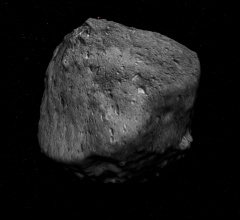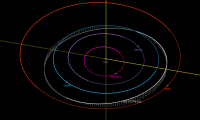162173 Ryugu
|
Project home: Ryugu-00.zip |
162173 Ryugu or in Orbiter simply Ryugu is near-Earth object of the Appolo group of small bodies, discovered by Lincoln Near-Earth Asteroid Research astronomers on 10 May 1999.
Ryugu is an add-on by francisdrake released in 2023 on the forum, and is compatible with Orbiter 2016. In Orbiter, Ryugu orbits the Sun with a semi-major axis of 1.19 AU, inclination of 0.1027 radians, and eccentricity of 0.19. Its gravity is very weak, even at the surface, in OrbitMFD, Ryugu's gravity is 1% and the Sun's gravity is 99%. A person could literally jump at greater than escape speed. Rotation is just over a day.
The landing surface (hard radius) is well inside the mesh/texture, so, landing on Ryugu places the spacecraft well inside the body.
Gallery[edit]
| edit The Solar System | |
|---|---|
| Central star |
Sun (Sol) |
| Planets |
Mercury - Venus - Earth - Mars - Jupiter - Saturn - Uranus - Neptune |
| Natural satellites |
Moon - Phobos - Deimos - Io - Europa - Ganymede - Titan - more... |
| Add-ons |
Planets - Dwarf Planets - Small objects - Natural satellites - Alternative star systems |

